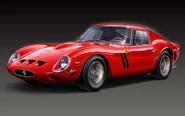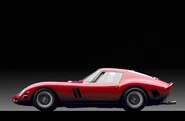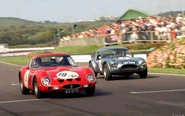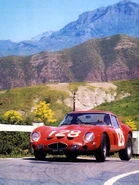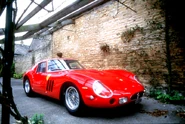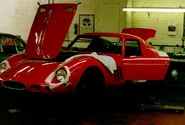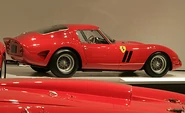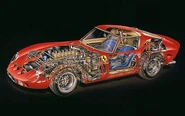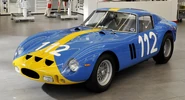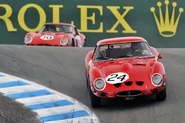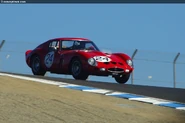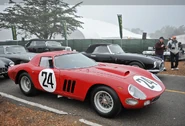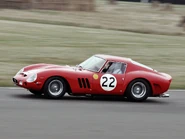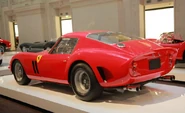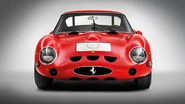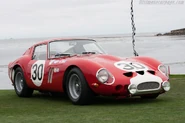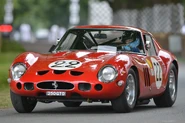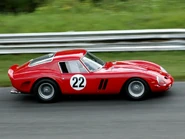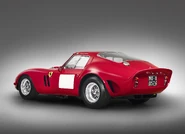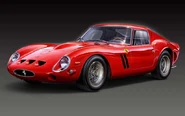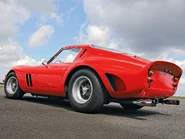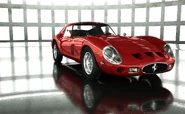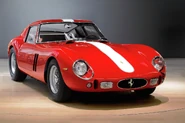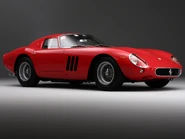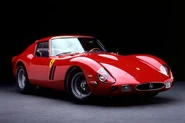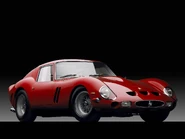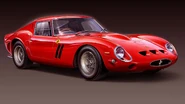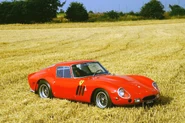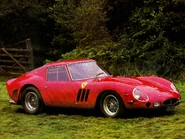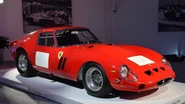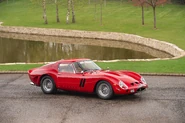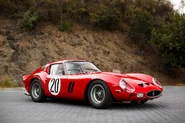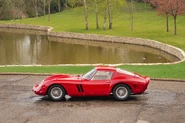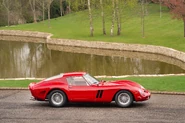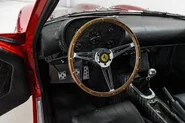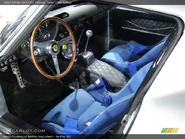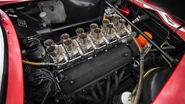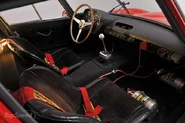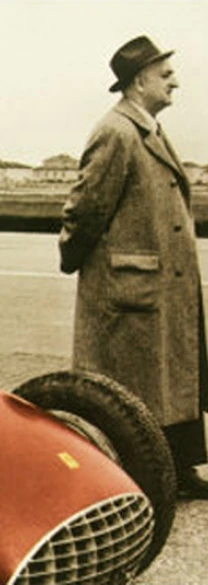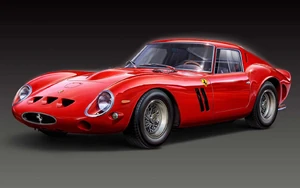
| |
| Ferrari 250 GTO | |
|---|---|
| Ferrari | |
| aka | Tipo 539/62 Comp 330 LMB / 330 GTO "Type 64" |
| Production | 1962 - 1964 39 units |
| Class | Supercar |
| Body Style | 2-door, 2-seat Berlinetta |
| Length | 4325 mm (173 in) |
| Width | 1600 mm (63 in) |
| Height | 1210 mm (48 in) |
| Wheelbase | 2400 mm (95 in) |
| Weight | 880 kg (1940 lbs) |
| Transmission | 5-speed manual, RWD |
| Engine | 3.0 litre (2953 cc) Type 168 60º V12 4.0 litre (3967 cc) Tipo 163 Colombo 330 60º V12 (330 LMB) |
| Power | 302 hp @ 7500 rpm 246 lb-ft of torque @ 5500 rpm 400 hp @ 7500 rpm (330 LMB) N/A (330 LMB) |
| Similar | Lamborghini Miura |
| Designer | Sergio Scaglietti and Giotto Bizzarrini Mauro Forghieri (engineering) |
The Ferrari 250 GTO is a supercar and auto racing car made by Ferrari in the early 1960s. It is widely considered to be the quintessential Ferrari model, and one of the greatest sports cars - indeed, one of the greatest automobiles - of all time.
The numerical part of its name denotes the displacement in cubic centimeters of each cylinder of the engine, whilst GTO stands for "Gran Turismo Omologata", Italian for "Grand Touring Homologated."
In 2004, Sports Car International named the 250 GTO number eight on the list of Top Sports Cars of the 1960s. Similarly, Motor Trend Classic named the 250 GTO as number one in their list of the "Greatest Ferraris of all time".
Development[]
The 250 GTO was designed to compete in GT racing. It was an orthodox (some would say conservative) evolution of the 250 GT SWB. Chief engineer Giotto Bizzarrini took the chassis from the 250 GT SWB and mated it with the 3.0 litre V12 engine from the 250 Testa Rossa. After Bizzarrini and most other Ferrari engineers were fired in a dispute with Enzo Ferrari, development was handed over to new engineer Mauro Forghieri and designer Sergio Scaglietti. The widely-admired body was developed from work done by Bizzarini and Scaglietti and perfected in wind tunnel and track testing. Unlike most Ferraris, it was not designed by a specific individual or design house.
The rest of the car was a well-balanced presentation of early-Sixties Ferrari technology: a hand-welded tube frame, A-arm front suspension and a live-axle rear end, disc brakes, Borrani wire wheels. The five-speed gearbox was a step forward, if not really revolutionary; the metal gate that defined the shift pattern would in turn become a tradition that is still maintained in current models. The interior was stripped-down and simple in the extreme, to the point where a speedometer was not considered necessary for the instrument panel.
Racing success[]
According to the FIA rules for sports car racing, at least one hundred examples of a car had to be built in order for it to be homologated in the GT class (as opposed to the less-restricted prototype class). However, Ferrari built only 39 250 GTOs (33 of the "normal" cars, three with four-liter 330 engines (sometimes called the "330 GTO" but properly the 330 LMB), and three "Type 64" cars with revised bodywork) but nevertheless the car was allowed to race in the GT class. Some say that Ferrari successfully argued that the model was technically a modification of the 250 GT SWB, some say that Ferrari's clout was such that it was better for the sport to allow the team to compete instead of dealing with a petulant (and crowd-depressingly absent) Scuderia Ferrari.
The car debuted at the 12 Hours of Sebring in 1962, driven by the team of American Phil Hill (the standing World Driving Champion) and Belgian Olivier Gendebien. Although originally annoyed that they were driving a GT-class car instead of one of the full-race Testa Rossas competing in the prototype class, the experienced pair impressed themselves (and everyone else) by finishing 2nd overall behind the Testa Rossa of Bonnier and Scarfotti.
The success was not a fluke; the 250GTO was an exceptionally capable racing car. At the time of its introduction it was (depending on choice of gears and final-drive ratio) most likely the straight-line fastest car on any race track; more subtly, but perhaps more important, it had no bad habits or nasty tricks in its wide performance envelope. In the best Ferrari tradition, it made normal drivers look excellent and gave great drivers an unsurpassable advantage. Years of development for its significant components, and traditional Ferrari robustness, also guaranteed that the car would last until the end of the race. In the end, the GTO won the World Manufacturer's Championship three years in a row: 1962, 1963, and 1964.
Production[]
The low production (39) allowed Ferrari to be selective about potential owners; if you were in the good graces of Ferrari himself, or his North American ambassador Luigi Chinetti, your $18,000 (early-1960s dollars, of course) would buy you the best GT racing car available at the time.
The 250 GTO arrived as perhaps the last car that could compete on such a level and still act as something of a normal road car; more visibly, it was one of the last front-engined cars to be truly competitive at such a level. In the age before vintage racing, the 250 GTO faced the same fate as any other racing car of its time: as it passed into obsolescence, some were kept as regional race machines, while others were used as normal (if barely-practical and thoroughly glorious) passenger cars. Interestingly, some fifty years later, it is thought that all 36 (or 39?) GTOs still exist. Many of which are still raced today in such events as the Monterey Historic Races at Laguna Seca.
Collectability and appreciating value[]
In the late Seventies and early Eighties, the focus of the "performance" of the 250GTO and other rare Ferraris turned out to be their rapidly-accelerating market value. As the auto industry struggled through new regulations and questionable marketing decisions, the unfettered performance machines of the recently bygone era took on a new desirability. There was also something of a paradigm shift; instead of being old but lovable racing cars, well-heeled collectors (Ralph Lauren among them) started to see the 250GTO and its brethren as a sort of drivable fine art, much like the coachbuilt luxury cars of the pre-World War II era.
This investment mentality reached an unreal peak in the late Eighties. As the wealth of certain members of the baby-boomer generation exploded and the stock market became a questionable investment, the market value of classic cars, especially Ferraris, went geometric - and as the much-touted great example of all the best traits of the breed, the asking price of the 250GTOs soared highest. One of them, seized by the FBI from a convicted drug dealer, was sold in a sealed auction in 1988 for approximately $2 million, which was considered outrageous at the time - and within three years would come to be seen as a good investment.
The money element, and the car's raw desirability and scarcity, have resulted in a number of faux 250GTOs being crafted on the base of more common Ferrari chassis; there are many more cars that look like 250GTOs on roads today than were ever rolled out of the Scaglietti coachworks. (The Alpha One 250GTO replica used the chassis and body of a Datsun Z-car and can be seen in the John Candy movie Delirious). In the opening scenes of the film Vanilla Sky, the main character drives a black 250 GTO, though this was later revealed to have been a different car altered to look like an original 250. On a more sinister level, misrepresentations of the original cars, with unscrupulous types attempting to sell them for full price, have been reported. One such example though he did not sell his was Charles Brocket, who had his passed off as a genuine example when it is was a replica and this only came to light when he was convicted of insurance fraud in 1996. The replicas sparked a famous saying that of the 3000 plus that have ever been built, all 39 are still running.
Prices peaked around 1991; although specifics are discreetly glossed over, it is common knowledge that a 250GTO traded hands in a private sale around this time for no less than fifteen million dollars.
The collector-car bubble burst in a very messy way not much later, but the price for legitimate high-demand Ferrari models has steadily climbed in the middle of the first decade after the millennium. Market value for a 250GTO in late 2006 is escalating to approach the earlier high mark; should one be lucky enough to consider ownership, a minimum of $10 million will be required.
Colors[]
There is currently two colors avalable:
- Street Edition: Red / Grey
- Race Edition: Red / Grey With Sponsers
Famous Owners[]
- Frank Beard (musician)
- Ralph Lauren
- Anthony Bamford, owner of JCB
- Nick Mason (drummer of legendary British band Pink Floyd)
- Yojiro Matsuda of the Matsuda Collection
Gallery[]
See Also[]
External Links[]
| Wikimedia Commons has media related to: 1962 Ferrari 250 GTO |
- Buckley, Martin & Rees, Chris (1998). World Encyclopedia of Cars. London. Anness Publishing. ISBN 1-84038-083-7
- The Ferrari Pages Cars From Italy (November 20, 2004)
- Ferrari 250 GTO Ultimatecarpage.com (October 2005)
- Supercars.net article on Ferrari 250 GTO
